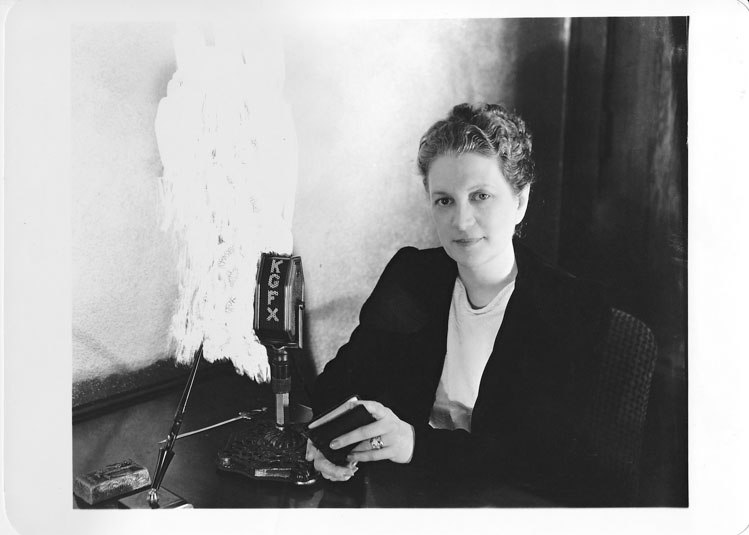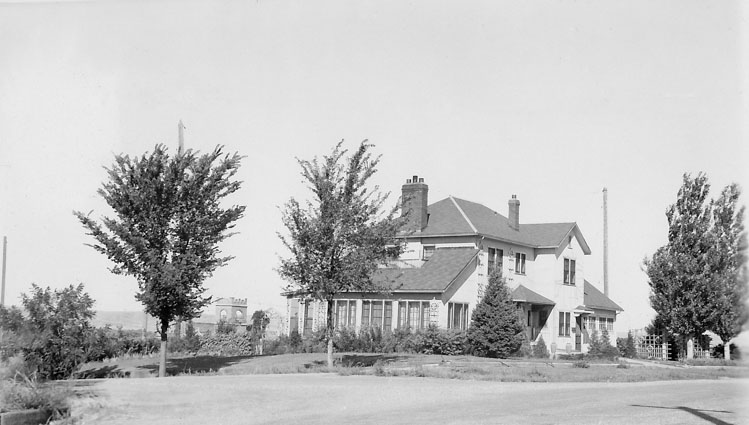The Gift of South Dakota
Subscriptions to South Dakota Magazine make great gifts!
Subscribe today — 1 year (6 issues) is just $29!
Goodnight, Mrs. Pierre
 |
| Pioneer radio broadcaster Ida McNeil used her microphone to creatively assist rural South Dakotans who had limited opportunities for communication in the 1920s and 1930s. |
Winter settled into the West River country as if it had come to stay. Ranchers couldn’t escape from their own yards for the drifts. Even the mailman couldn’t make his rounds. It was the 1950s, and communication was the first casualty of bad weather.
“The roads were completely blocked. We were having lots of snow that winter, and we hadn’t had the mail for well over a week,” recalls Phyllis Fravel, who still lives in the Orton Flat area near Mission Ridge.
Fortunately, ranchers had one slim connection to the outside world. Several times a day, a woman’s voice came crackling across all that cold and distance in the friendly static from radio station KGFX. Many listeners couldn’t have said who she was — she never gave her name over the air but once, from the time she started broadcasting in 1922 until the time she sold the station in 1962. They called her Mrs. Pierre.
Her name was Ida McNeil. She was a widow by then, broadcasting from a studio in her house in Pierre, just the way her husband, Dana, had taught her when they were puzzling out this new gadget, radio, together. One of the things she quickly learned is that people needed public service news — if the post office was planning to use extraordinary measures to deliver the mail, for example.
“Carl Kerr decided to deliver the mail by airplane and he told us through the radio — Ida McNeil — that they would be out with the plane,” Fravel recalled. “Cecil Ice was the pilot and Carl Kerr was the mailman. They landed just a short distance from the house and he left our mail and some of the neighbors’ mail at our place.”
For Fravel, watching a ski plane land on her ranch because Mrs. Pierre had said it over the radio was nothing unusual. It was just the way people communicated about many things, including the doings at Orton School, where Fravel herself had been a teacher. You talked to Mrs. Pierre; she talked to central South Dakota.
Residents who remember her said Mrs. Pierre was invaluable, inventing a service that didn’t exist before radio. “I would make up a message and get it to Ida McNeil, and she would put it on the radio that we were going to have a party on such and such a date. That’s the way we got the word around,” Fravel recalled. “If there was somebody that was in town and got stranded, they would send a message that as soon as the snowplow got out, they would be home.”
“She was a groundbreaker. There was nothing to model after,” said Mark Swendsen of Pierre, chief executive officer of Ingstad Family Media, the company that has owned KGFX since 1968. “She had a keen sense for what the community needed.”
And the community stretched far and wide. Carol Jennings recalls that when she was growing up on a farm south of Highmore, about an hour east of Pierre, her parents were always tuning in to KGFX. “I remember Mom had the radio on all the time to listen to ‘Ma Pierre,’ they called her.”
They listened because the news was curiously intimate. Ida McNeil carried messages from wedding parties worried about forgotten dresses and from sons in the Navy who’d come down with diphtheria, asking KGFX to pass word to the family back in the Plains that everything was going to be all right.
“She did a great service for the people in this area at that time,” adds Betty Harding of Pierre. “What they appreciated so much with KGFX is that she would give the hospital report and tell who had had a baby, who was in the hospital, who was being discharged.”
Mrs. Pierre couldn’t pass a message from one party to another because of federal rules. But what she could do, and did, was announce it to everyone. An article by Ida B. Alseth in Coronet magazine in March 1947 described why that sort of news item mattered to central South Dakota: “There are some 221,000 persons in Mrs. McNeil’s listening audience, and they seldom miss one of her broadcasts. For them, KGFX is not just another radio station; it’s an over-sized country party line where they may listen in for the latest bits of news and gossip — and often a deep chuckle.”
A chuckle, and maybe a sigh of relief. “During the bad winters, Mrs. Pierre was a vital thing for the whole community. Everybody listened when she came on. They counted on her,” said Willie Cowan of rural Pierre.
“I don’t know what my Virgo horoscope would say, but it seems to me I must have been born under a star of communication — which included rivers, railroads and radio, from the Mississippi to the Black Hills,” Ida McNeil said at the outset of a speech she gave in 1970 to the Minnilusa banquet in Rapid City, where she moved in the 1960s after she had sold the station.
“My mom was the oldest of five girls and her father was a riverboat engineer. That’s how they got to Pierre,” remembers Richard McNeil, the younger of Ida’s two sons, now 92 and living in Rapid City.
Mrs. Pierre was born Ida Anding in 1888. In 1896, Chicago Northwestern railroad officials asked her father to go to Pierre to supervise the overhaul of the machinery of a steamer, the Jim Leighton, Ida told in her speech. The Jim Leighton is well known in local history as a ferry that operated between Pierre and Fort Pierre. Ida and her sisters and their mother came out to Pierre that June and found the South Dakota capital hot and dry.
Eventually Ida went to work for what was then South Dakota’s Department of History from 1906 to 1921 as clerk, legislative reference librarian and finally as an assistant to Doane Robinson, secretary of the South Dakota State Historical Society, who saw that she found her niche in state history in small ways. She left there about the time she married a widower from down the block, Dana McNeil.
 |
| KGFX, the 12th radio station to be licensed by the federal government, was operated from the big McNeil house on West Broadway in Pierre. Radio was such a new concept that the local newspaper reported on some of Ida's unusual broadcasts, especially when she assisted rural families in times of crisis. |
“My dad was much older than my mom. She was his second wife,” Richard McNeil says. “He got his interest in things electrical when he was in high school. He grew up in Clarence, Iowa, on a farm, and the railroad had a siding there. They parked a boxcar there with a guy who was a telegrapher. My dad learned to read code, and when he got out of high school, he got a job as a telegrapher with the railroad and gradually moved west and ended up in Chadron. He was involved in a lot of the railroad building in those days.”
But telegraphy was a 19th century invention; the next big thing had already arrived. “When he got to Pierre, he got interested in amateur radio,” his son said. He also became interested in Ida, who was about 20 years younger.
As Ida told in her Rapid City speech in 1970, “On June 16, 1916, Dana McNeil was licensed by the U.S. Department of Commerce to operate a radio station he had built. The call letters were 9 Z P, later becoming 9 C.L.S., with 200 watts of power. We were married in November of 1921 and my radio work began in February of 1922.”
And it all began in the McNeil home — what some Pierre residents remember as the big yellow house at the top of the hill on West Broadway in Pierre.
Dana taught Ida to read Morse code, and then they experimented with her broadcasting voice. Because Dana had moved into a position as a conductor on the route between Pierre and Rapid City, she started transmitting short messages to him; soon they learned that others were listening.
As Ida told in her speech, “One morning a young woman came to see me and asked me if I would tell her mother by radio how she was getting along after the operation she was to have at the Pierre hospital. Of course I did — but thereupon all the patients wanted me to tell their folks how they were doing. At first the doctors were dismayed and thought it was unethical to make such public announcements, but eventually when they found what a useful service it was they gave us their complete cooperation.”
Ida’s hospital report became a big deal in the middle of South Dakota. “Her main thing was ‘resting fairly well,’” says Loretta Cowan, of rural Pierre. But there were variations, open to interpretation; such as ‘doing as well as expected.’ “If she said that, you might be in a little bit of trouble,” Cowan said.
It wasn’t all public service announcements and weather. There was live local music, too. Danny Hall of Fort Pierre remembers when he was asked to sing and play guitar on KGFX when he was about 10 years old in the 1950s. The station’s most important days came with the flood of 1952, Ida later recalled. And the greatest honor might have come when McCall’s magazine announced in early 1957 that Ida was one of seven women in radio and TV who had won the McCall’s Golden Mike award for 1956. Ida was recognized for service to the community. “The personal impact of her broadcasts is so great that her listeners, among them Governor Joe Foss and Mayor A.E. Munck of Pierre, refer to her affectionately as ‘Mrs. Pierre,’” the magazine reported.
Newspaper clippings stored at the state archives show what a stir Ida’s broadcasts made. Radio was so new that even the newspapers reported on what the McNeils were broadcasting.
The Potter County News noted on Jan. 20, 1926: “In giving the hospital report Tuesday, the Pierre radio station announced the birth of a child to Mr. and Mrs. Jay Eidom of Forest City. Another item broadcast was that a Highmore school teacher had passed away from the effects of small pox and that the school at Highmore had closed as a result.”
The Pierre Daily Dakotan carried this item on Feb. 15, 1926: “Philip, S.D. — An unusual use of the radio was made near here when Mrs. R. B. Trenchard of Milesville was notified of the death of her father at Janesville. A telegraph message was sent to the McNeil broadcasting station at Pierre and was broadcast from there. It was picked up by receiving sets in the vicinity of Milesville and Mrs. Trenchard was notified. She left the next day for Janesville to attend the funeral.”
The McNeils’ station became KGFX on Aug. 15, 1927. It was approved as a 200-watt station, and the 12th amateur station licensed by the federal government.
“We made no charges for any of our radio services until 1932 and only once, on my 50th birthday, did I ever announce my name,” Ida recalled. “I would have felt very self-conscious to that all day long, since practically all the announcing was mine.”
The station started a longer broadcasting schedule and commercials in 1932. Ida became sole director after her husband died in 1936.
The McNeils’ eldest son Robert — who retired as a colonel after a military career that included teaching at West Point — also became interested in broadcasting. Richard, the younger, was more interested in the technical aspects. “That was the founding interest for me in becoming an electrical engineer,” he says. He taught at the South Dakota School of Mines and Technology in Rapid City for 35 years.
Through the years, many newspapers — Pierre, Rapid City, Sioux Falls, even the Minneapolis Tribune — sent writers to watch Ida do her thing. She sold the radio station in 1962 to Black Hills Broadcasting Co. and subsequently watched as it grew to a 10,000-watt station. Ingstad bought it in 1968 and the family has owned it ever since.
South Dakota State University recognized Ida as a broadcast pioneer in 1970. Her peers elected her to the South Dakota Broadcasters Hall of Fame in 1972. She died in August 1974.
Perhaps the greatest reward for Ida Anding McNeil as a broadcaster might have been the work itself. Perhaps that’s why she snapped back into her old role in her 1970 Rapid City speech.
“I will never forget the solemn wonder I felt at the marvel of radio — knowing that your voice, unseen, was reaching people far away, perhaps with a message of comfort or cheer,” she said. “Perhaps I should close by saying what I have said for many years — ‘This is Station K.G.F.X. at Pierre, operating on an assigned frequency of 630 kilocycles, now leaving the air. Goodnight.”
And to you, Mrs. Pierre.
Editor’s Note: This story is revised from the November/December 2017 issue of South Dakota Magazine. To order a copy or to subscribe, call (800) 456-5117.










Comments